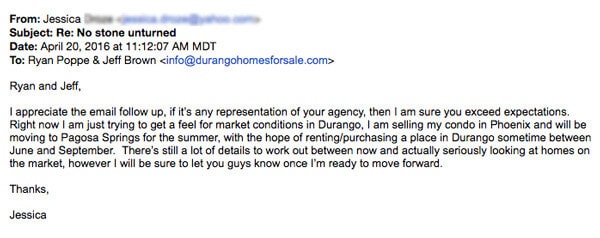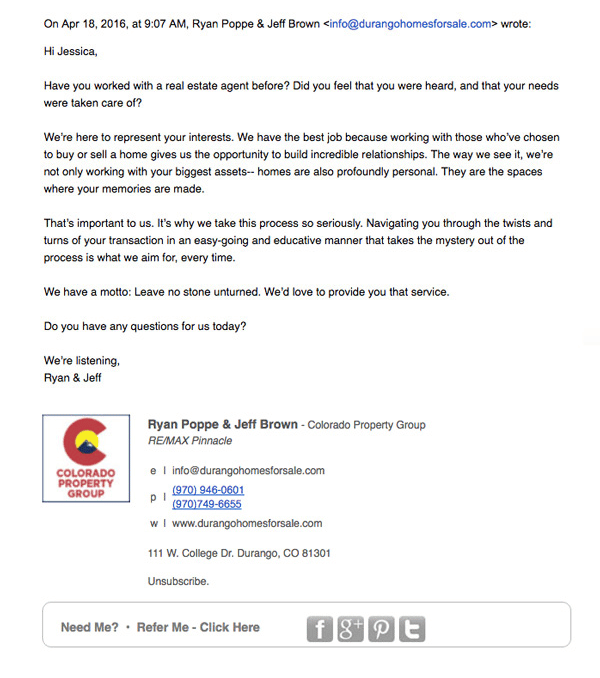“I appreciate the email follow-up.
If it’s any representation of
your agency, then I am sure you
will exceed expectations…”

This is an actual reply to the drip campaigns that Ryan Poppe and Jeff Brown, real estate agents in Durango, CO, are sending from Happy Grasshopper. The best part is it’s not the only one. They get replies like this weekly. Are you ready to send email replies that lead to closings?
Ryan took the time to reach out (thanks, Ryan!) to let us know about all the replies his Happy Grasshopper emails have been getting.
This is what the perfect follow-up reply looks like:

The Best Lead Follow Up Email Example…

Pretty awesome, right? And it’s all due to the messages Ryan and Jeff have been sending that:
- Are engaging, personal, and show they’re about building relationships.
- Ask questions and use the information gap, driving Jessica to respond.
- They continue to send.
You’ll notice the follow-up email doesn’t contain any of the following phrases: “Just following up,” “I am following up on,” “Just checking in,” etc. You probably see these phrases constantly in follow-up emails, and everybody else does too. Precisely because they’re so common, and because they don’t signal that the email contains anything of immediate value, they often fail to engage a recipient’s attention. Are those email replies that lead to closings?
You’re not “just checking in” your email has a purpose. You’re trying to accomplish something, obtain further information, maybe even close a sale, and you won’t achieve that if your email doesn’t generate a response.
Why Ryan & Jeff’s Message Is The Perfect Follow Up to Get Email Replies that Lead to Closings
Ryan and Jeff’s follow-up message is an effective email, and the three points above are crucial. With all that understood, though, let’s break the process down a little further. To create an effective follow-up email, you should go through these eight steps:
- Define your objective.
- Write your email with the recipient’s experience in mind.
- Begin with context.
- State the purpose of the email clearly.
- Make sure there’s value for the recipient.
- Give some thought to the closing.
- Craft an effective subject line.
- Send the follow-up email.
When writing your email, start by making sure you know exactly what the email is intended to achieve. One goal is to obtain additional information. You may want to send this kind of email after an initial contact or if you’re checking on the status of a real estate deal in progress. In either, or any case, make sure you’re specific about what you need.
Another common objective is to set up a meeting with your lead. Again, you want to be specific about what the meeting is intended to achieve and how that will be of value to your contact. Without knowing that, why should the recipient set aside time to see you? (Adding a link to free meeting scheduling software makes it particularly easy for recipients to add themselves to your calendar.)
Yet another common goal is catching up. Perhaps you haven’t heard from the recipient in a while, or perhaps you’ve heard about big changes at his or her company, changes that could affect the way your two businesses interface, but you haven’t gotten it straight from the source, as it were. Once again, specificity is your friend here. If you can say what you’re hoping to hear about or share, the recipient is likely to feel you’re genuinely interested in him or her and more likely to make time for you.
A final objective is saying “thank you.” This might not generate an immediate response, but it’s pretty much always appreciated and creates a favorable impression the recipient will remember down the road. It’s appropriate to express your gratitude when the recipient gives you a referral, helps you with a review or case study, concludes a deal with you, or on any number of other occasions.
Whatever the specific purpose of the follow-up email, defining that purpose generally enables you to incorporate a clear CTA (call to action) that is likely to pull a quick response.
Keep in mind who you’re talking to and put yourself in that person’s place. Do you like being pestered every day, talked down to, or given a hard sell? Chances are, neither does the recipient
What Type Of Email Subject Lines To Use?
It’s important to lead with context because so many recipients are buried in email every day if you want email replies that lead to closings. That being the case, you want to immediately remind the recipient who you are and what the context of the initial contact was…..especially in the subject line of the email. Otherwise the recipient may decide that later is time enough to puzzle out what the email is all about or even delete it on the spot. (Naturally, this step is especially important if the recipient doesn’t already know you well, if you’ve only had one relatively brief contact, for example, or it’s been a while since the two of you communicated.)
Once you nail down the context, get to the point and state the purpose of the email. Busy recipients will appreciate that you’re not wasting their time. Your clarity and directness will keep the message from seeming annoyingly vague, untrustworthy, or confusing and work in the service of your CTA.
Make sure that when you indicate the purpose of the email, you demonstrate that acting on it has value to the recipient and not just to you.
It may seem counter-intuitive that creating your subject line is Step #7. Your impulse may be to write it in advance of the message itself. By writing the body of the email first, however, you clarify its purpose in our own mind, and that helps you compose the strongest, most eye-catching subject line possible.
Concrete times and numbers help make a subject line strong. So do words like “quick” and “tomorrow.” Studies show that emails with those words in the subject line were opened more often.
Or, if you want to use a different approach altogether, you can try omitting the subject line. Somewhat surprisingly, research found that emails without a subject line were opened more often, but you may not feel this is appropriate for your business. You might feel, for example, that it creates an image that is less than professional.
Close in a way that’s cordial, personal, and feels natural to you. This is one more chance to make a favorable impression, so there’s no need to settle for “Sincerely” unless something less stereotypical just feels wrong to you.

Finally, of course, having composed a strong, well-crafted email with a clear CTA, you’ll need to send it. Different time frames work best for different types of message. “Thank you” emails should go out within 24 hours. A fairly urgent message (perhaps after you’ve provided important documentation) should go out in 24 to 48 hours. 1-2 weeks is good if you’re following up on a meeting request or checking if the recipient actually got a previous email that didn’t generate a response the first time. Catching-up emails are appropriate every 3 months or so.
The situation that might make you feel most uncomfortable is one where you already sent an email and the recipient didn’t reply. You may feel that the lack of response indicates lack of interest and that you’re both imposing and wasting your time if you write again.
That’s not necessarily the case, however. Research found a significant response rate to the sixth follow-up email, so it’s clear that persistence can pay off.
If you’re sending a series of unanswered follow-up emails, though, the duration between them should increase with each so you don’t create the impression you’re pestering the recipient. An automated system can help you keep track of the timing and space out follow-up emails appropriately.
With all that said, let’s get back to our example.
Jessica replied to the third email Ryan and Jeff sent through Happy Grasshopper. She sees their continued follow-up as evidence they care, and through the HG system, Ryan and Jeff will continue to nurture that relationship by staying in touch long-term.
Here’s how Ryan put it:
“Obviously, we do extensive phone follow-up and send listing updates, but this specific lead didn’t have a phone number attached. A great part about Happy Grasshopper is you can somewhat forget about a lead and let the quality content take over.
We receive at least one of these a week. :)”
Want to see more examples of amazing follow-up? Give us a call and we will demonstrate. We’ll show you exactly how Happy Grasshopper creates email follow-up perfection.

